Support Hidden Compass
Our articles are crafted by humans (not generative AI). Support Team Human with a contribution!
Cricket Aglio e Olio, Yum Bug
Gremolata:
- 4 tbsp flat leaf parsley
- ½ lemon zest
- 1 garlic clove
Crickets:
- 1 oz whole crickets
- 2 tbsp olive oil
- Salt and black pepper
Aglio, Olio, e Peperoncino:
- 1 red chili
- 8 garlic cloves
- ½ cup olive oil
- 8.8 oz spaghetti
- ½ lemon
Prep the gremolata: Finely chop the parsley and garlic clove. Zest the lemon. Combine in a small mixing bowl and mix well.
Cook the crickets: Heat the olive oil in a frying pan, then fry the crickets for 1-2 minutes. Remove from the heat, season with salt and black pepper, then stir them into the gremolata. Set aside.
Now cook the spaghetti. Finely chop the red chili and garlic. In a frying pan, combine the olive oil with the garlic and chili, then turn the burner on low, being sure to keep the heat gentle. Once the garlic becomes fragrant and starts to soften, remove it from the heat.
Transfer the contents of the frying pan to a warmed serving bowl. Once the pasta is just cooked, use tongs to transfer it to the serving bowl. Toss it well to coat the pasta in the oil, then add a squeeze of lemon and the crickets in gremolata. Mix everything together, season to taste.
~~
As I scanned the beautiful spread, my heart sank when I saw the scorpions — my edible-insect nemesis. A whole pile of fried scorpions for garnish, and a scorpion-powder chili for one of the mains.
While I tried to reason with the part of my brain that screamed, “Eeeeewww!!!” — it’s just food, it smells delicious, you love chili — I helped myself to taster portions of everything else. The theme for this year’s event was Native American food, so there were dishes like black-bean tamale with black ants; chapulines (Mexico’s signature grasshoppers) salsa with corn chips (a riot of flavor; I went back for seconds); wild rice with juniper berry sauce and cedar-brushed mealworms; spicy cricket pumpkin bread; and insect pemmican (the original Native American protein bar — traditionally a mix of meat, fat, berries, and seeds).
It was all wonderfully creative — and absolutely delicious.
Buoyed by my positive experience, I decided to try the scorpion chili. It was rich and incredibly flavorful, with just the right amount of spice. As I savored the dish, I felt silly for initially refusing to try it. It was some comfort to hear that others had felt the same way.
“I could not try the whole scorpion — the look was a little bit too much for me,” said Marissa Peters, a microbiology student who was attending the buffet for the first time. “But everything tasted a lot better than I honestly thought it would.”
At another table, seasoned buffet-goers Elizabeth Green, a teacher, and her 11-year-old son, Sam, were finishing their plates. “This is the fourth year in a row we’ve done the buffet,” she said. “I really, really enjoyed the scorpion chili. And I was shocked: The salsa made of scorpions — I mean, that was gourmet.”
I eventually plucked up the courage to try a whole scorpion. It was salty, a bit tough, and disturbingly fishy. Definitely an acquired taste, I thought.
At least one of my fellow diners had acquired it.
“How can they taste so good?” she enthused as she chomped on a whole one.
“They’re basically shrimp,” her friend replied.
The fact that insects are closely related to crustaceans is small comfort to most people who have grown up with the idea that insects are emphatically not food. What usually brings them around to the idea of eating them is that bugs can be delicious — which is precisely what the Bug Buffet at Montana State University (MSU), held on the campus in Bozeman, has been demonstrating for the past 33 years.
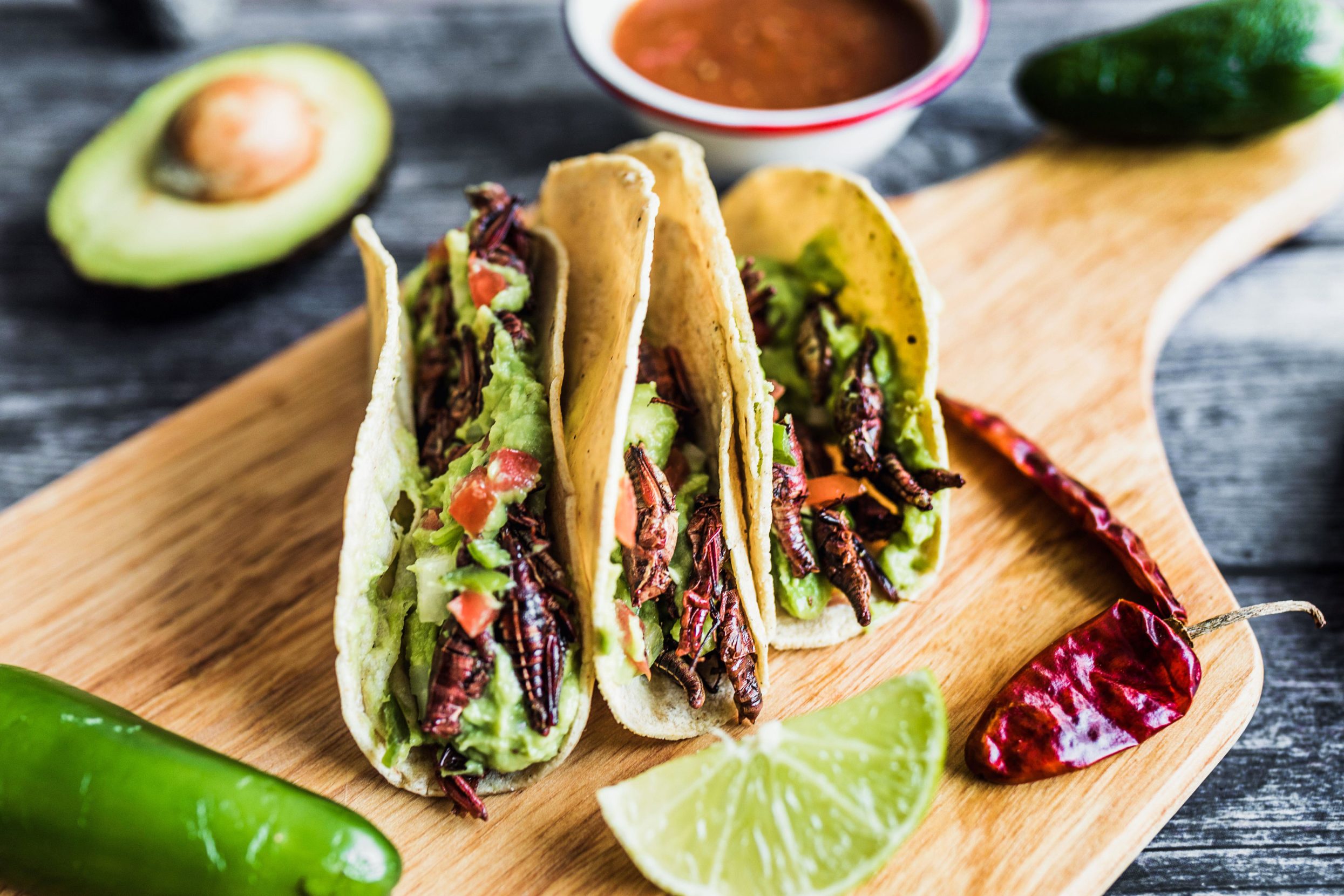
Grasshoppers — like these prepared in tacos, with homemade guacamole — are a nourishing ingredient in cuisines the world over. Yet in Africa, says entomologist Florence Dunkel, international aid organizations long insisted on using pesticides to control them — a decision that had a severe impact on nutrition. Photo: Marcos Castillo / Alamy.
~~
The first time I heard about the Bug Buffet was in late 2019, when I read an academic publication about the evolution of the insect-protein movement. I’d recently become interested in this emerging industry after I came across projects in Madagascar that were using insect protein to tackle malnutrition and reduce dependency on bushmeat from endangered animals.
As I learned about these initiatives, I was shocked by my own prejudices toward insects as food — and amazed by their potential as a sustainable protein alternative. After all, they require less land, water, and feed than conventional livestock, and can be reared on certain types of food waste and agricultural waste.
This revelation came at a key time in my life, as I was starting to make meaningful changes to reduce my environmental footprint. Bugs struck a chord. Here was a truly circular farming system, whose adoption in the West relied on redefining our definitions of food. I was hooked.
And the Bug Buffet sounded like a marvelous event: a thousand people gathering every year to eat delicious insect dishes. And in Montana, of all places — prime beef country, where there are two-and-a-half times as many cattle as people. I loved the quirkiness of the concept, and the incongruity of the setting. I knew I had to go.
Thanks to the pandemic, though, I didn’t make it there until March of this year. By then, I had become something of an insect-industry nerd, writing lots of articles on the topic and editing and publishing a dedicated newsletter called Buzzing. In the course of my research, I frequently came across the Bug Buffet’s founder: an entomologist at MSU named Florence Dunkel.
Dunkel had edited a newsletter about edible insects in the 1990s and 2000s — long before newsletters were a thing, or insect protein was even a concept in most Western cultures. She seemed far ahead of her time. I was deeply intrigued.
Our initial Zoom calls had revealed that my newsletter-writing counterpart was feisty, busy, on the bohemian side of tidy, at home with abstract concepts and deeply interested in people and cultures.
I couldn’t wait to meet her.
~~
It’s one thing to write essays about ethnocentrism, another to work out how to integrate chai cricket powder into your grandma’s shortbread recipe.
On the opening day of the Bug Buffet, Dunkel is easy to spot: The entire ballroom seems to be moving toward her on what I soon learn is a big day.
Dunkel, who will turn 80 in October, is retiring, and this is her last buffet. A petite woman with a halo of wavy gray hair, twinkling dark eyes, and a mellifluous voice, she has an energy that belies her age.
“She’s pretty good when she gets some sleep,” says her daughter Anne Marie, who has flown in from Virginia to help.
Dunkel — who in 1988 became the first female department head at MSU’s College of Agriculture — is a famously hard worker: I’ve received emails from her during the late morning in the U.K., which means they were sent at 3 a.m. in Montana. Her sprightly 88-year-old husband, Bob, is also on hand.
As are students, professors, and other staff from across the university. The Bug Buffet is as much about eating delicious food as it is about learning why bugs can be great to eat.
On one side of the ballroom, Dunkel’s students have set up display tables. Some educate attendees on how insects have been consumed in Native American cultures. Others provide information on the small environmental footprint of insect production. One shows visitors how to rear mealworms at home.
Carefully ironed black tablecloths are dotted with colorful fake bugs. On some display tables, someone has even gone to the trouble of laying trails of fake ants. I can’t imagine another catered event where these would be deemed appropriate decorations.
Elsewhere, people are handing out relevant academic papers and edible-insect recipes (dishes such as spicy mealworm mac-and-cheese and banana bread with mealworm powder).
Dunkel warmly greets everyone. Countless students, past and present, stream up to greet her. When I introduce myself, I notice a beautiful turquoise beetle brooch on her burgundy jacket.
“What is it?” I ask her.
“Well, it’s up to you,” she says with a chuckle. “The only thing that really matters to us entomologists is that it has six legs.”
~~
One day in early 1989, an entomologist from the U.S. Department of Agriculture, who had a lab down the road from MSU, complained to Dunkel that his colleagues didn’t know what to do with all the grasshoppers they were rearing. Dunkel, who had worked in Asia and Africa for years, offered to take them and cook them for the students in a class she was teaching called “Insects in Society.”
When she fried the lot in a pound of butter, the critters were a hit with her students and colleagues.
Dunkel was in Rwanda the first time she had a “transformative” culinary experience eating grasshoppers. “I love soft-shelled crab,” she says, “and that’s what they tasted like. Ever since that moment, when I see a grasshopper or we talk about it, I salivate and I think, Oh, I want to have another experience like that.”
The year after her fried grasshoppers were a hit, Dunkel invited colleagues from other colleges. The year after that, more students came. By the mid-1990s, students were regularly inquiring about the “bug buffet.” Dunkel thought the name was a little informal, but by then it had taken on a life of its own.
Over the years the Bug Buffet has grown into a broader event involving faculty and students from various departments — business, nutrition, catering — as well as the public. It’s become a fixture on the calendar for both MSU and Bozeman.
The growth of the Bug Buffet has paralleled the rise of the global edible-insect industry. In 2013, for instance, the United Nations’ Food and Agriculture Organization (FAO) published a seminal report titled Edible Insects: Future Prospects for Food and Feed Security. Written by Arnold van Huis, an emeritus professor at Wageningen University in the Netherlands, with input from Dunkel and 75 other experts, the report covered all aspects of insects as food and animal feed. It received global media coverage and was downloaded two million times within days of its publication.
The FAO report brought the idea of consuming insects into the larger debate on the impact of global food production. Livestock production accounts for 77 percent of the world’s agricultural land, much of which is used to grow crops for animal feed such as soybeans, and for up to 14 percent of all anthropogenic greenhouse-gas emissions.
Insect farming, on the other hand, is much more controlled and efficient. Bugs are better than livestock at converting feed, they have shorter life cycles, and they can be farmed vertically (in stacked crates), so they take up less space.
The Aspire Food Group, for example, has pilot cricket farms in Texas and Ghana; its main facility will start operating this autumn in Ontario, Canada, and is expected to produce up to 26 million pounds of crickets per year on a 12-acre plot. The same plot used for livestock would yield 1,500-2,000 pounds of beef — at best.
The global interest in insect protein that followed the FAO report prompted Dunkel to expand the programming of the Bug Buffet. In 2015 she decided that the event would explore a particular theme each year. Topics so far have included environmental entrepreneurship, education, and nutrition. She also added keynote speakers, an academic conference, and, in 2018, a student cook-off.
“It just got bigger and bigger,” says Holly Hunts, an economist at MSU and the Bug Buffet’s co-organizer. “That’s how I got involved. They needed me to budget. Florence has the vision. I am Mrs. No. She does it anyway, and then I scramble for money.”
~~
When the Bug Buffet began, Dunkel cooked all the food herself.
In the early 1990s, “[we served] boiled wax moth larvae as appetizers while [attendees] waited for the grasshoppers,” Dunkel says. “We would give people a toothpick for them to dip the larvae in cocktail sauce or ranch dressing.”
Grubs, or larvae, are the one thing I don’t see much of at the buffet this year — much to my disappointment. I’d been hoping to tick lots of new critters off my list at the event. But supply-chain issues had it otherwise.
This year, says Rob Strauch, sous-chef at MSU, those issues were “one of the biggest factors in deciding what we’d put on the menu.”
“Scorpions are pretty expensive,” adds Chipper Darcy, MSU’s executive chef. “We have cooked with them before, and we know people want to try them. But we had to manage our costs.”
Someone has even gone to the trouble of laying trails of fake ants. I can’t imagine another catered event where these would be deemed appropriate decorations.
Born and raised in a Sicilian family in Wisconsin, Dunkel is a keen cook and a self-described gourmet. She and Bob have always hunted their meat (elk and deer) and grown their fruits and vegetables. Dunkel particularly likes baking, and her insect brownies have become legendary on campus.
In 2013, Dunkel received an award for teaching excellence at MSU, which came with a cash prize of $2,500. It was January, and the Bug Buffet was scheduled for February. So Dunkel decided to put the money to good use by hiring the university’s catering team to do the cooking.
“It was the best decision,” she says. “It encouraged other [departments at MSU] to get more involved, like the College of Business.”
Fortunately, Dunkel didn’t have to pay catering costs out of her own pocket the following year, having found alternative funding with the help of Hunts.
Chef Darcy has overseen the buffet for the past seven years. He says it’s been a steep learning curve. The first couple of years, “I made the mistake of overpowering [the dishes] a little bit. I’d taste [one] and think, ‘This is really buggy.’ You want to be able to taste it, but you don’t want to overpower it.”
Since 2018, he and his colleagues have received coaching from famed chef and edible-insect ambassador Joseph Yoon of Brooklyn Bugs. In the rarefied world of edible insects, Yoon — whose catchphrase is “Bug Appetit!” — is a superstar. A former saxophone player and music executive, Yoon ran a private catering business until 2017, when he got the edible-insect bug and founded an organization, called Brooklyn Bugs, to promote the idea.
His exuberant persona (he describes himself as “serious, with a side of crazy”), insect-embroidered chef’s jackets, and eye-catching food soon earned him a loyal following on social media. Yoon earned even wider acclaim for his work with the Brood X cicadas that emerged in the eastern U.S. in the spring of 2021, after having been dormant for 17 years. As the country succumbed to cicada-mania, Yoon’s recipes for Brood X nymph kimchi and Brood X chili-garlic nymphs in cold cauliflower, potato, and leek soup appeared everywhere from The Washington Post to the BBC.
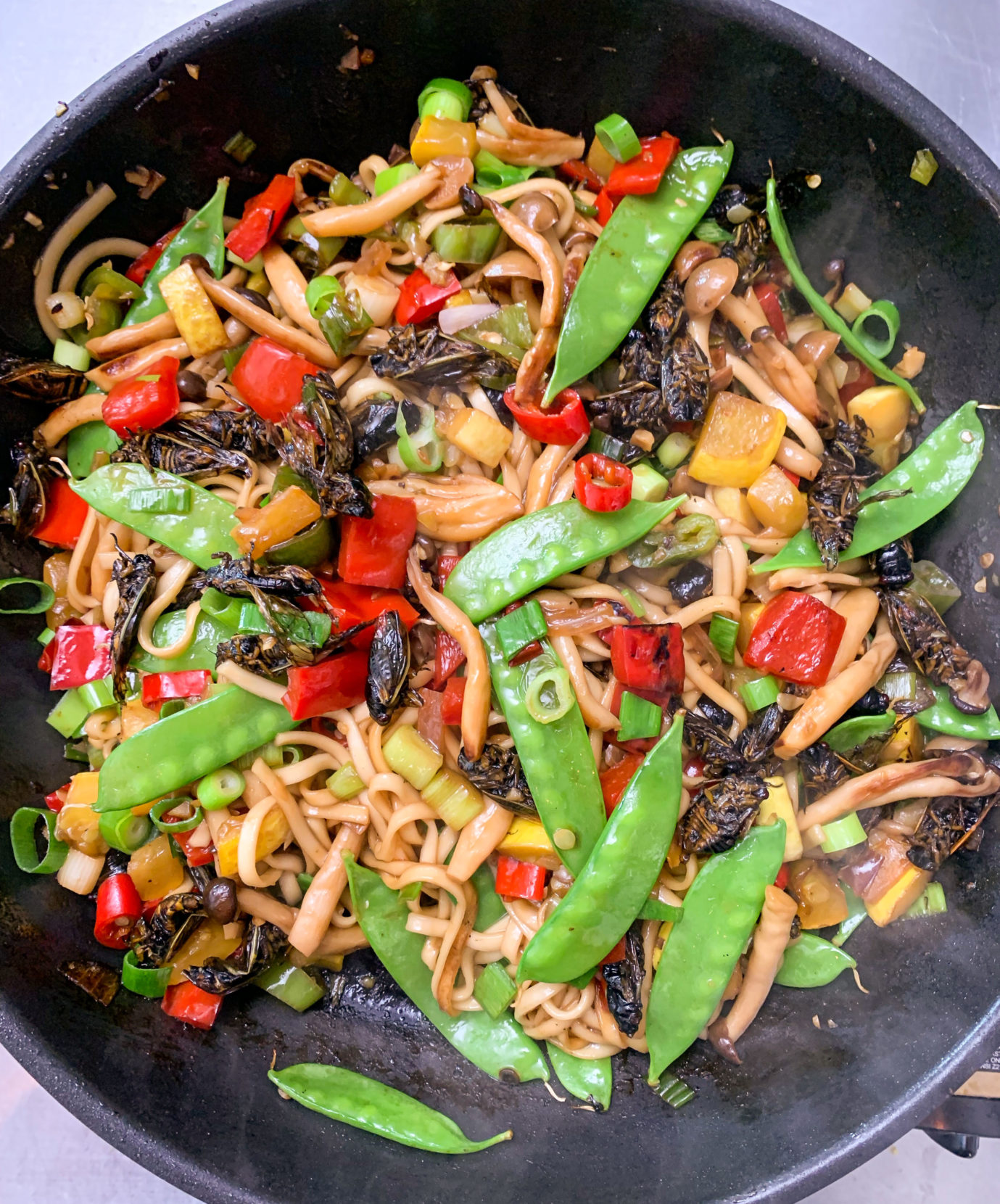
This cicada stir fry was prepared by famed chef Joseph Yoon, an ambassador for the edible-insect movement. Yoon rose to national prominence last year, when his recipes for Brood X cicadas appeared everywhere from The Washington Post to the BBC. Since 2018 he’s been advising Montana State University’s executive chef, Chipper Darcy, who prepares many of the dishes for the annual Bug Buffet. Photo: Joseph Yoon.
This year is the first that Darcy and his team have worked without Yoon. “I think he would be proud of us,” says Darcy, glancing at the busy ballroom.
I watch people going back for seconds (and thirds), preparing sample trays to take back to their friends or colleagues elsewhere on campus. I squirrel away a couple of pieces of the perfectly moist pumpkin bread for later.
In the afternoon, as I chat with Hunts, who’s by the door with a clicker, we’re interrupted by Edwin Alan, a Ghanaian doctoral student in food science. A friend of his brought some samples to their office earlier, and he’s dropping by to offer feedback.
“Wow, that stew — I loved it!” he says, referring to the scorpion chili. “It tasted just like Ghanaian food. Forget the environment, it just tastes amazing.”
~~
Dunkel moves a pile of documents from the settee and sits down. A strange roasting smell wafts into the room from the hallway. “They’re sterilizing the lab’s equipment,” she explains.
We’re in Dunkel’s lab on the edge of campus between events. She’s given me a lift here in her beat-up Honda (“200,000 miles on the clock,” Bob informs me).
Her office is bursting at the seams with 50 years’ worth of research — piles of papers, books, maps, photos of fieldwork, poster presentations from academic conferences.
Dunkel’s work has always focused on biocontrol — pest control using microorganisms to manage unwanted insects. When she started, in the 1960s, it flew in the face of the prevailing orthodoxy, which was to use pesticides.
Her research took her to not just Rwanda but Mali and China, and around the U.S., where she developed a deep interest in Native American culture. Wherever she worked and whatever she worked on, what struck her was how Western “experts” systematically ignored Indigenous knowledge of food and agriculture.
“I understood ‘decolonizing methodologies’ and ‘Native sciences’ before there were words for these concepts,” she says.
In Mali, Dunkel saw firsthand how the West’s perception of insects as pests affected people’s livelihoods. Insects are an important part of the diet of Malian women and children. (Insects contain all nine essential amino acids, as well as vitamin A, vitamin B12, magnesium, calcium, iron, zinc, fiber, and antioxidants).
But Dunkel says that international aid organizations insisted on using pesticides to control locusts and grasshoppers, which had a severe impact on nutrition.
“Our countries — France, England, Germany, the U.S. — literally waged war on locusts and grasshoppers in Africa,” she says. “The FAO were scratching their head about how to alleviate malnutrition in sub-Saharan Africa, and the answer [was] insects. The answer was there 40 years ago, but we just couldn’t see it.”
This mindset is what Dunkel has been working so hard to change. She’s published extensively about it, and it’s what the Bug Buffet is fundamentally about: chipping away at the notion that insects are not food. Once a niche party for entomologists, the Bug Buffet became an essential tool in Dunkel’s mission to promote insects as a sustainable protein source with a place in Western agriculture.
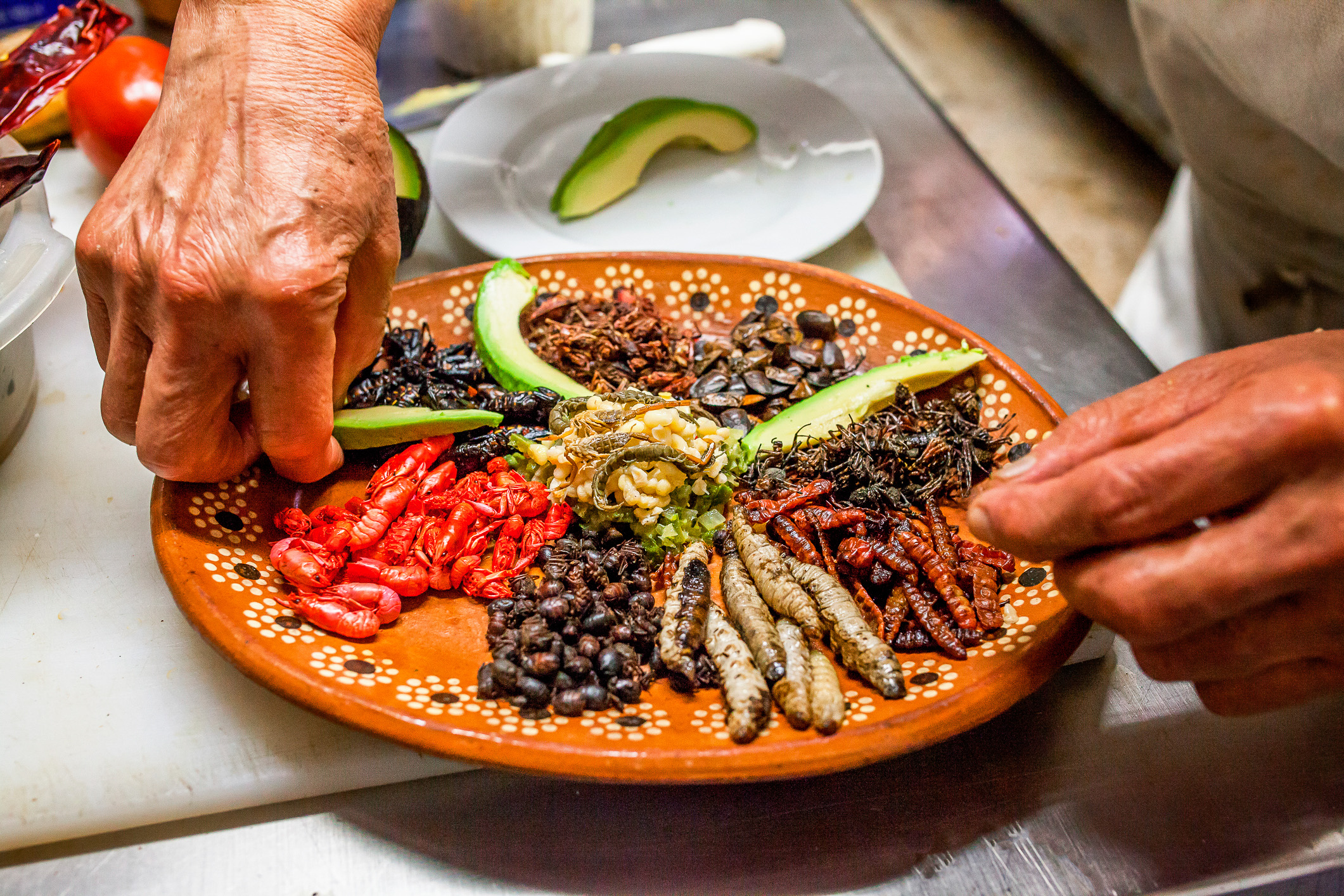
A chef in Mexico prepares a sampler platter of worms, scorpions, flying ants, larvae, jumil, and more. Insects were a key part of the country’s pre-Hispanic cuisine, and remain a staple of Indigenous diets around the world. Photo: Fito Pardo / Getty Images.
~~
At 10 a.m. on Saturday, the kitchen in Hannon Hall is buzzing with activity. Nine students from the Insects in Society class are prepping for the Bug Buffet’s student cook-off, the last event of the week.
The students may be united in their belief that eating insects is a good thing, but they’re a bit of a motley crew when it comes to cooking. Some work in restaurants — I can see one student using a practiced roll-cut technique. Others are complete novices. “[The supervisor] told me how to make fried rice this morning,” Jonas Kahila, a soft-spoken freshman majoring in economics, says sheepishly.
As someone who’s been messing around with edible insects for two years, I’d been most looking forward to this part of the buffet: realistic inspiration from amateur cooks, rather than unachievable, Instagram-perfect chef recipes.
Dunkel introduced the competition as a way to get her students to interact with the subject in a different way. It’s one thing to write essays about ethnocentrism, another to work out how to integrate chai cricket powder into your grandma’s shortbread recipe.
Four teams compete to make the best insect dish. They’ll judge one another’s dishes, which will be served to the public. For students, it’s a chance to earn both kudos and extra credit for their class. Dunkel and her daughter have also prepared token prizes — cooking utensils and chocolate — as a thank you for participating.
All the ingredients are laid out on a large kitchen counter. There are familiar products — beans, avocados, cornmeal, squashes, fresh and dried peppers, chocolate — and lesser-known ones, such as amaranth grain and yuca root. “Anything you can do with a potato, you can do with yuca,” says KayAnn Miller, a chef at MSU who is chaperoning the students.
As for insects, there are whole crickets; flavored cricket powders and spices (pico grillo, Maya chocolate, chai); grasshoppers; ants; and mealworms — purchased locally and online from well-known retailers by Dunkel and Hunts.
Two of the teams have decided to make traditional dishes with an insect twist, such as a chili with grasshoppers and cricket powder, and a “Three Sisters” stew (corn, squash, and beans) with mealworms and cricket seasoning. A novel offering is fried wild rice with roasted squash and crickets.
“We didn’t have a super-detailed plan,” says Kahila, laying his squash in a large roasting tray. “But I think the use of bugs is really cool!”
At the other end of the kitchen, Lillian Hewitt, who is majoring in sustainable agriculture with a minor in entomology, is crushing cane sugar for her huckleberry, blueberry, and black-ant sorbet. Teammate Jason Fly, a conservation biology student, is chopping shallots for the black-ant guacamole. It’s Hewitt’s first cookoff, Fly’s second.
“We’re going to win it — smash it out of the ballpark,” Hewitt says with a mischievous grin.
“With the impact of agriculture on climate change, we need to shift to more sustainable food sources,” says Fly. “Bugs are the way to go. They’re hard to come by, but I buy them whenever I see them.”
~~
When I drop in an hour later, things have taken an unexpected turn.
“The sorbet is not setting, so we’re going for a compote instead,” says Fly casually.
The team also went for a last-minute rogue dish: yuca chips.
“We had plenty of time, so we thought chips seasoned with cricket spices would be great with the guacamole,” Fly explains.
At 12:30 p.m. Miller asks the students to bring their dishes out. The judging panel gives the chili a thumbs-up for its sweet notes, and the fried rice gets points for originality. But it’s the yuca chips, guacamole, and sorbet-turned-compote that carry the day.
“You can take your mask off now, Joseph Yoon,” says David Wodrich, who cooked the chili, to a triumphant Hewitt.
That afternoon, Hewitt, who works in a hip pizzeria in Bozeman, took a jar of black ants to use on a trial pizza for her colleagues. She hopes they’ll eventually put insects on the pizzeria menu.
I picture Hewitt on her shift making black-ant pizza, and I think, This is exactly what Dunkel had intended: She was planting a seed.
~~
“The answer was there 40 years ago, but we just couldn’t see it.”
Looking back, it’s remarkable that the Bug Buffet started in the late 1980s, when eating insects was something of a taboo subject in the field of entomology. It’s a period that Dunkel refers to as the “dark ages.”
At the time academia was dominated by the Eurocentric view that insects weren’t food, and universities were unwilling to support research in the field. One thing that sustained Dunkel and her fellow edible-insect enthusiasts was The Food Insects Newsletter.
Founded in 1988 by Gene de Foliart, an entomologist at the University of Wisconsin-Madison, the newsletter began as an attempt to bring together people interested in using insects for food and animal feed. De Foliart also wanted to find out whether anyone still ate insects in tropical countries.
The first issue was published in July 1988 and read by a hundred people. The first few editions were littered with anecdotal, often humorous evidence — supplied by readers — of the widespread use of insects. This July 1986 telegram from the U.S. State Department, printed in the March 1989 edition, is a good example:
Subject: Locust and grasshopper treat — Burundi. Criquet migrateur [migratory locust] began entering Burundi in May and June from Tanzania […] The only defensive measures reportedly taken to date by local residents in affected areas has been to gather them up and eat them.
The first printed recipe — for mealworm quiche — appeared in the fourth issue, in 1989. The Bug Buffet was first mentioned in March 1991. Dunkel began editing the newsletter in July 1995, the year she received tenure at MSU. By then, it had more than a thousand subscribers and a pay-as-you-go model. It had also become a more serious publication, each issue filled with academic papers, research news, and a growing section on insects in the media.
This was all done on a voluntary basis, in Dunkel’s spare time. But in 2007 she gave up being the editor. Following a reshuffle at MSU, she’d been transferred to the Department of Plant Sciences and Plant Pathology, and denied her first request for a full professorship.
“It was affecting what was perceived as my productivity by the university,” she says. “When it came time to be promoted from associate professor to full professor, anything to do with edible insects was not considered productive.”
Dunkel made two further requests for full professorship, the second in 2017. But she was never promoted.
This affected her earnings, of course, not to mention the academic prestige that comes with a full professorship. Yet as she prepares to retire from teaching, she says she has no regrets.
“I could have brought legal suit,” she says, “but it would have stopped the conversation [about eating insects] — and that was more important to me.”
Hunts, who is also retiring this year, says that Dunkel’s advocacy has had a real impact.
“Florence has made big inroads in the agriculture department, which is traditionally focused on Big Ag — cattle, grains, wheat, barley, potatoes,” says Hunts. “You have to be tough to do that, especially at the time Florence started. But Florence has done it by continuing the Sisyphean task of pushing. It’s taken her a lot of years, but [perceptions are] shifting. And it’s wonderful to see.”
MSU has now added an edible-insect section to its catering menu — the first land-grant university in the U.S. to do so. Dunkel also says that the university’s Department of Agriculture now accepts that insects are food, a significant shift.
“Once you realize that, it opens the door to thinking beyond settler mentality,” she says. “For instance, we grow European crops in the U.S., and they do well. But growing Indigenous crops would be better for us and for the planet.”
~~
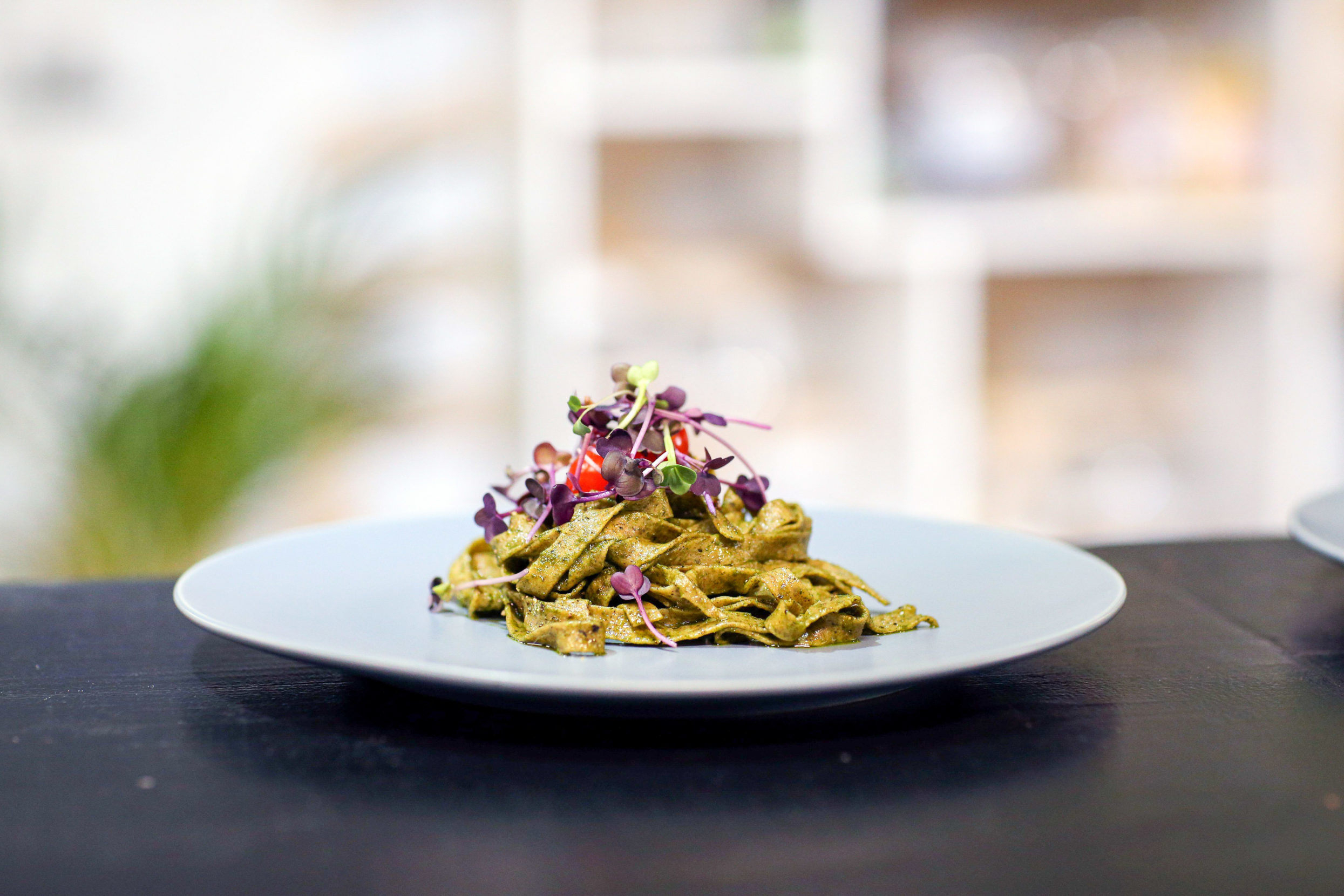
This tagliatelle alla insetto is a pasta dish made with black-soldier-fly larvae flour, wheat, and basil pesto. But bugs aren’t only for haute cuisine. Dozens of insect farms across Europe and North America are now raising black soldier flies for animal feed as well — a means of production much more efficient than growing soybeans on land where livestock is produced. Photo: Sumaya Hisham / REUTERS.
Each display table at this year’s Bug Buffet has a pile of survey sheets. Since 1991, the buffet has asked respondents whether they accept the idea of insects as edible protein. The first year, the acceptance rate was less than 20 percent. This year, it was around 90 percent — the highest level yet.
The global insect-protein industry is booming too. According to Rabobank, a Dutch multinational bank, the sector has already raised more than $1 billion in financing since 2015. Barclays, the British universal bank, forecasts it will be worth $8 billion by 2030.
The EU-affiliated nonprofit International Platform for Insects as Food and Feed (IPIFF) predicts that edible-insect production will jump from 551 tons per year in 2019 to more than 286,000 tons by 2030. The production of insects for animal feed may rise from 11,000 tons in 2020 to more than 550,000 in 2030.
Across Europe and North America, dozens of insect farms are now operating or under construction. Bugs are being raised for food (mostly crickets) and animal feed (mostly black soldier flies and mealworm). And existing farms are constantly improving their efficiency.
Last December, I visited Protix, the world’s largest black-soldier-fly farm, in the Netherlands. CEO Kees Aarts told me that the company had already exceeded every performance target it had set for itself, just two-and-a-half years after opening the plant. The farm now produces 4,463 tons of protein per acre per year. By comparison, soy produces a little more than half a ton of protein per acre each year.
Dunkel says she’s delighted to have advised, taught, and championed many “entopreneurs,” chefs, and academics in the field. But she’s not done yet. Her university career may be coming to an end, but she plans to keep advocating for insect protein. She’s been contacted by other researchers and universities keen to learn from the Bug Buffet. And she’s eager to encourage people to grow mealworms at home — another leap forward in insect-protein acceptance.
One of the recipes handed out at the main event this year was Dunkel’s own, hand-signed recipe for sautéed grasshoppers. Montana is bracing for large numbers of grasshoppers this year, thanks to perfect conditions for egg hatching, so Dunkel thought it would be timely. The cooking instructions — “remove head and pull the foregut and midgut with the head segment” — strike me as audacious.
Wouldn’t cricket powder be less daunting than prepping grasshoppers? I ask.
“I take chances,” Dunkel says. “This Bug Buffet is a chance.”
~~
Florence Dunkel’s sautéed grasshoppers
- 5-10 grasshoppers per serving
- Vegetable cooking oil
- 2 tbsp butter for 6 servings
- Soy sauce to taste
- Cayenne powder to taste
- Onion powder or sliced onions
- Green pepper
- Garlic powder (optional)
- Salt and black pepper
Grasshoppers should be gathered and starved for 24 hours (to clear their digestive systems) or fed wheat bran. Freeze for 1-4 hours.
Remove from freezer. Place in plastic bag and roll gently between your hands. This will easily remove most legs and wings. Remove remaining legs and wings. Remove head and pull the foregut and midgut with the head segment. (Note: The head is only the first ovoid segment in front of leg area.)
The terminal segments of the abdomen, particularly in female grasshoppers, are often heavily sclerotized. These can be removed and the remaining hindgut pulled with the terminal segments. The hoppers are now ready for frying or marinating immediately.
Immerse grasshoppers in soy sauce.
Place grasshoppers and sliced onions and green pepper in hot oil and butter. Sauté, stirring constantly, for 5 minutes. Add spices as preferred.
Serve immediately, with or without bread.
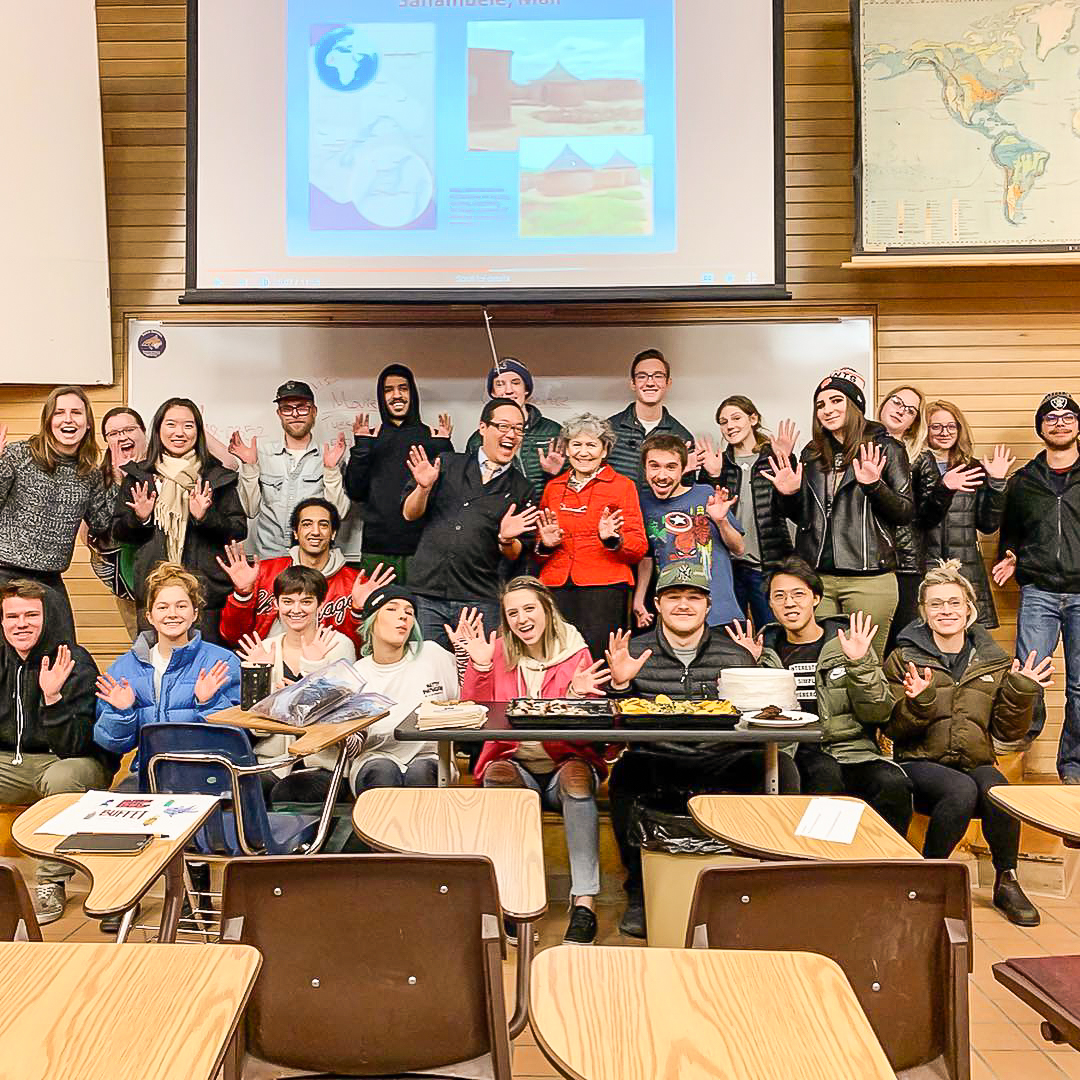
At Montana State University, edible-insect doyenne Florence Dunkel, larger-than-life chef Joseph Yoon, and Dunkel’s students wave goodbye to the Western notion that bugs aren’t food. Courtesy Joseph Yoon.
Emilie Filou
Emilie Filou is a freelance journalist specializing in the environment, business, sustainability and development issues, with a particular interest in Africa.



